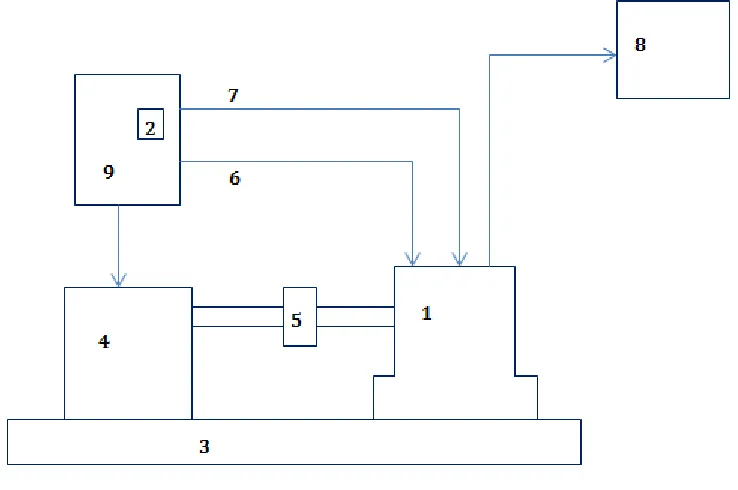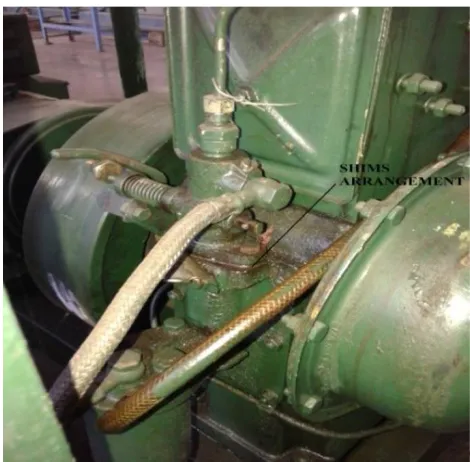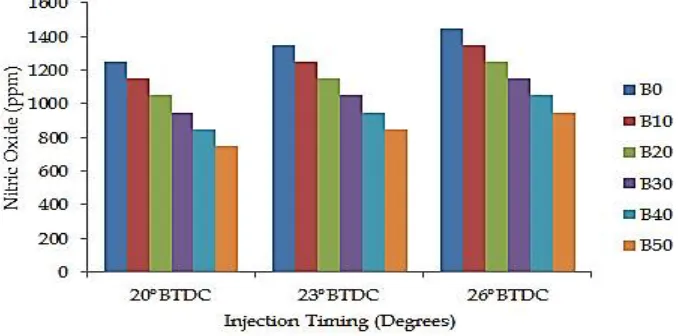Effect of Injection Timing on Compression
Ignition Engine Fuelled with Thevetia
Peruviana Biodiesel
P.A.Harari1, A.J.Deokar2, S.D.Jadhav3, R.P.Narvekar4, P.Y.Nimbalkar5, V.A.Kamble6 Assistant Professor, Department of Mechanical Engineering, Sant Gajanan Maharaj College of Engineering,
Mahagaon, India1,2
B.E Final Year Students, Department of Mechanical Engineering, Sant Gajanan Maharaj College of Engineering,
Mahagaon, India3,4,5,6
ABSTRACT:In the present study an experimental work had been carried out to analyse the performance and emission
characteristics of various blends of ThevetiaPeruviana biodiesel by varying injection timings. The engine tests are conducted on kirloskar, 4-stroke, single cylinder, 1500 rpm, water cooled, direct injection, diesel engine with eddy current dynamometer with standard injection pressure 230 bar and injection timing 23°BTDC was maintained constant throughout the experiment. 3 different injection timings such as 20°BTDC, 23°BTDC and 26°BTDC varied to analyse the performance and emission characteristics. From the test results, it could be observed that among 3 different injection timings 26°BTDC gives higher efficiency and lower emissions as compared to other two injection timings.
KEYWORDS:Blends, Compression Ignition, Emission, Timing, Performance.
I. INTRODUCTION
Pradeep at el. [1] studied influence of injection timing on emission parameters of Adelfa biodiesel (Nerium oil methyl ester – NOME) fuelled DI CI engine. In that work, transesterifiedAdelfa oil (Nerium oil methyl ester – NOME) was used as the test fuel and the results were compared with diesel fuel. The injection timing was retarded to 24°BTDC and advanced to 30°BTDC and 33°BTDC. Results showed that, for all load conditions and for all injection timings the brake thermal efficiency was found to be maximum at three fourth of load condition. The maximum efficiency was obtained with diesel fuel to a value 25.608%. The decrease in the efficiency were found to be 11.71%, 3.71% and 3.87% when the injection timings were 24°BTDC, 27°BTDC and 33°BTDC. The brake thermal efficiency was found to be 25.502% when the injection timing was 30°BTDC.
Prabhakar et al. [2]studiedoptimization of esters of Nerium biodiesel in a diesel engine. In this work, methyl and ethyl esters of Nerium oil were prepared by transesterification using both methanol and ethanol. The Nerium oil blends were prepared in the proportion of 20%, 40%, 60%, 80% and 100% with diesel. Results showed that, the brake thermal efficiency was highest with diesel in all loads. The maximum efficiency was obtained for methyl esters of Nerium oil (MEON) blends compared with ethyl esters of Nerium oil (EEON) blends.
Suresh et al. [3] studied performance and emission evaluation of a DI diesel engine using Nerium oil as alternative fuel. In this work, the performance and emissions characteristics were evaluated on single cylinder four stroke water cooled diesel engine which was capable of developing a power output of 7.5 kW at 1500 rpm fuelled with 20%, 30% and 40% of Nerium oil blended with diesel. Results showed that, the blends of Nerium oil showed lowest specific fuel consumption than diesel at part loads. Mechanical efficiency for NO 30 was higher compared to diesel fuel. Brake mean effective pressure was also increased as the percentage of the Nerium oil increases with the diesel. The volumetric efficiency was raised as the blend of Nerium oil increases in the diesel.
Lalvani et al. [4] studiedDI diesel engine with renewable biodiesel – Adelfa. In this work, Adelfa oil methyl esters (AOME) were prepared using transesterification process and tests had been carried out in direct injection single cylinder diesel engine with their blends such as AOME 10, AOME 20, AOME 30, AOME 40 and AOME 100. Results showed that, diesel showed the superior brake thermal efficiency on all loads. Brake thermal efficiency of the engine was reduced by increased blend ratio of Adelfa biodiesel with diesel.
John et al. [5] studied performance, emission and combustion parameters of a direct injection diesel engine using Eucalyptus and Nerium biodiesels as fuel. In this work, an experimental investigation on the performance, emission and combustion characteristics of two different biodiesels – Nerium and Eucalyptus biodiesel, in a single cylinder direct injection diesel engine. Both Nerium and Eucalyptus biodiesels were blended separately with diesel fuel 30% by volume (N30 and E30) and the various characteristics were studied. Results showed that, maximum BTE of the engine using diesel was observed to be around 28.6%. There was a marginal decrease in the BTE of nearly 6.9% while using E30 blend as the fuel. The BTE of the engine for N30 fuel blend was found to be further lower than that of both diesel and E30 blends.
Harari et al. [6] studied effect of nozzle hole geometry on compression ignition engine fuelled with ThevetiaPeruviana biodiesel and found that, among three different nozzles 5 hole nozzle gives higher thermal efficiency as compared to 3 and 4 hole nozzles.
Jogdhankar et al. [8] conducted experiments on alternative fuels and performance of CI engine running on neem oil and biodiesel blends. In this work, different blends of neem oil-diesel and neem biodiesel-diesel in varying proportions (10%, 20%, 30% by volume) were prepared. Tests were conducted at different injection pressure such as 200 bar and 220 bar. Results showed that, at higher loads the BTE of N20 was slightly higher than diesel and low for N10. The blends B10 and B20 shows slightly higher BTE at high loads followed by B30 and diesel. It can be concluded that, the blend B20 at 220 bar injection pressure can be used as an alternative fuel to diesel.
Yadav et al. [9] conducted experiments on performance parameters of single cylinder four stroke DI diesel engine operating on neem oil biodiesel and its blends. In this work, experiments were carried out to analyze the performance of different blends 20%, 50%, 100% of neem oil biodiesel. Results showed that, the BSFC and BSEC were higher and BTE was less for biodiesel, when compared to diesel fuel. The BSEC was increased by 0.60% to 8.25% and BTE was decreased by 0.57% to 7.62% at 12 kg engine brake load as compared to diesel fuel. BSFC for biodiesel was increased by 2.5% to 19.5% than that of diesel fuel for B20, B50 and B100 blends at 12 kg engine brake load.
Nithyananda et al. [10] conducted experiments on performance study on diesel engine using different blends of neem biodiesel. In this work, different blends of neem biodiesel-diesel were prepared such as (10%, 20%, 30%, 40% and 50%). The tests were carried out on single cylinder water cooled diesel engine using different blends of neem biodiesel at variable loads. Results showed that, neem blends B10 and B20 have specific fuel consumption close to diesel. The blend B50 shows higher SFC than other blends at all loads. Blend B50 shows the minimum BTE at full load. It can be concluded that, B20 blend can be used as alternative fuel without any engine modification.
1.1. Objectives
To study ThevetiaPeruviana blends in single cylinder diesel engine as an alternative fuel.
To increase the Brake Thermal Efficiency (BTE) and reducing emissions of diesel engine.
To study the best suitable injection timing for existing engine in terms of performance and emissions.
II. METHODOLOGY
Collection of raw oil of ThevetiaPeruviana.
Transesterification reaction to convert raw oil into biodiesel.
Prepare blends with diesel such as B0, B10, B20, B30, B40, B50.
Determine fuel properties such as Density, Kinematic viscosity, Flash point, Fire point, Calorific value.
Single Cylinder, Water Cooled, 4-Stroke, 1500 RPM, 5.2 kW, 230 bar Injection Pressure, 23° BTDC Injection Timing, Hemispherical Combustion Chamber, 3 Hole Nozzle, 17.5:1 Compression Ratio engine is used for the study.
Change the injection timings such as 20° BTDC, 23° BTDC, 26° BTDC.
Determine performance and emission characteristics Brake Thermal Efficiency, Brake Specific Fuel Consumption, Total Fuel Consumption, HC, CO, NOx, Smoke emissions.
2.1. Properties of fuels
Table 1 Properties of fuels
Property B0 B10 B20 B30 B40 B50
Density (kg/m3) 829 835 839 841 843 846
Viscosity at 40°C (CSt)
3.52 3.76 3.96 4.09 4.22 4.71
Flash Point (°C) 53 68 77 81 83 87
Fire Point (°C) 59 75 86 89 92 95
Calorific Value (MJ/kg)
42.19 41.82 41.45 41.18 40.92 40.31
III.EXPERIMENTAL SETUP
A single cylinder, direct injection, four-stroke, water cooled, Compression Ignition (CI) engine is used in the experimental study. The fuel flow rate was measured by noting down the time taken for the consumption of a known quantity of fuel (10cc) from a burette. The viscosity of raw as well as esterified oil was measured by red wood viscometer, density by hydrometer, calorific value by bomb calorimeter, flash and fire point by open cup method. Initially, before starting experimental tests, the engine was made to run under ideal condition as warm up phase and then the tests were conducted. The engine was started and allowed to warm-up for about 10 minutes. The engine was tested under five discrete part load conditions i.e. 20%, 40%, 60%, 80% and 100%.
Fig 1 Experimental Setup
3.1. Engine specifications
Table 2 Engine parameters
Engine Parameter Specifications
Engine Type Kirloskar
No. of Strokes 4
No. of Cylinders 1
Type of Cooling Water Cooling
Type of Injection Direct Injection
Bore 87.5 mm
Stroke 110 mm
Compression Ratio 17.5:1
Rated Power 5.2 kW
Rated Speed 1500 rpm
Injection Pressure 230 bar
Injection Timing 26° BTDC
3.2. Changing injection timing
The fuel injection timing can be varied by adjusting shims provided between fuel pump and engine body which is as shown in Fig 3.
Fig 3 Photographic view of shims
IV. RESULTS AND DISCUSSIONS
4.1. Brake thermal efficiency
Among all the blends tested B0 blend gives higher brake thermal efficiency because of higher calorific value of the B0 blend. Among different injection timings tested 26°BTDC gives the higher brake thermal efficiency because with the advancing in injection timing from 20°BTDC to 26°BTDC there is much time availability for the mixing of fuel and air and hence brake thermal efficiency increases.
4.2. Brake specific fuel consumption
Among all the blends tested B0 blend gives lower brake specific fuel consumption because of lower viscosity of the B0 blend. Among different injection timings tested 26°BTDC gives the lower brake specific fuel consumption because with the advancing in injection timing from 20°BTDC to 26°BTDC there is much time availability for the mixing of fuel and air and hence brake specific fuel consumption decreases.
Fig 5 Variation of brake specific fuel consumption with injection timing
4.3. Total fuel consumption
Fig 6 Variation of total fuel consumption with injection timing
4.4. Hydrocarbon emissions
Among all the blends tested B0 blend gives lower HC emissions because of better mixing of the B0 blend with the air. Among different injection timings tested 26°BTDC gives the lower HC emissions because with the advancing in injection timing from 20°BTDC to 26°BTDC there is much time availability for the mixing of fuel and air and hence HC emissions decreases.
4.5. Carbon monoxide emissions
Among all the blends tested B0 blend gives lower CO emissions because of better mixing of the B0 blend with the air. Among different injection timings tested 26°BTDC gives the lower CO emissions because with the advancing in injection timing from 20°BTDC to 26°BTDC there is much time availability for the mixing of fuel and air and hence CO emissions decreases.
Fig 8 Variation of carbon monoxide emissions with injection timing
4.6. Nitric oxides emissions
4.7. Smoke emissions
Among all the blends tested B0 blend gives lower smoke emissions because of better mixing of the B0 blend with the air. Among different injection timings tested 26°BTDC gives the lower smoke emissions because with the advancing in injection timing from 20°BTDC to 26°BTDC there is much time availability for the mixing of fuel and air and hence smoke emissions decreases.
Fig 10 Variation of smoke emissions with injection timing
V. PROJECT OUTPUT
ThevetiaPeruviana biodiesel can be successfully used in diesel engines.
ThevetiaPeruviana biodiesel can partially replace for diesel fuel successfully.
By changing injection timing we can increase the Brake Thermal Efficiency (BTE) and reduce emissions.
VI. CONCLUSIONS
The brake thermal efficiency for 26°BTDC injection timing was found to be higher as compared to other injection timings.
Brake specific fuel consumption for 26°BTDC injection timing was found to be lower as compared to other injection timings.
Total fuel consumption for 26°BTDC injection timing was found to be lower as compared to other injection timings.
Hydrocarbon and carbon monoxide emissions for 26°BTDC injection timing were found to be lower as compared to other injection timings.
Nitrogen oxide emissions are lower for 26°BTDC injection timing was found to be higher as compared to other injection timings.
Smoke emissions for 26°BTDC injection timing were found to be lower as compared to other injection timings.
Hence 26°BTDC injection timing is recommended for existing diesel engine.
Among the biodiesel blends tested, B10 and B20 gave the best performance with reduced emissions.
REFERENCES
1. A.R.Pradeep, K.Annamalai, S.R.Prem, “Influence of Injection Timing on Emission Parameters of Adelfa Biodiesel (Nerium Oil Methyl Ester – NOME) Fuelled DI CI Engine”, International Journal of Innovative Technology and Research, 2013, 1(1), 99-102.
2. S.Prabhakar, V.N.Banugopan, K.Annamalai, S.Jayaraj, “Optimization of Esters of Nerium Biodiesel in a Diesel Engine”, Indian Journal of Science and Technology, 2011, 4(3), 170-172.
3. K.Suresh, G.Naidu, A.Venkata, “Performance and Emission Evaluation of a DI Diesel Engine Using Nerium Oil as Alternative Fuel”, International Journal of Engineering Research and Technology, 2013, 2(9), 2510-2517.
4. I.J.Lalvani, M.Parthasarathy, D.Balasubramaninan, K.Annamalai, “Experimental Investigation on DI Diesel Engine with Renewable Biodiesel – Adelfa”, National Conference on Green Engineering and Technologies for Sustainable Future 2014, Journal of Chemical and Pharmaceutical Sciences, 2014, Special Issue-4, 240-242.
5. C.B.John, M.Subramanian, “Study of Performance, Emission and Combustion Parameters of a Direct Injection Diesel Engine using Eucalyptus and Nerium Biodiesels as fuel”, International Journal of Science, Engineering and Technology Research, 2014, 3(4), 692-698. 6. Deokar, Harari, Sutar, Hodage, Patil, Kole, “Effect of Nozzle Hole Geometry on Compression Ignition Engine Fuelled with
ThevetiaPeruviana Biodiesel”, International Journal of Innovative Research in Science, Engineering and Technology, 2018, 7(12), 11861-11871.
7. N.Tyagi, A.Sharma, “Experimental Investigation of Neem Methyl Esters as Biodiesel on CI Engine”, International Journal of Engineering and Applications, 2012, 2(4), 1673-1679.
8. S.R.Jogdhankar, S.D.Bharadwaj, “Alternative Fuels and Performance of CI Engine Running on Neem Oil and Biodiesel Blends”, International Journal of Environmental Sciences: Development and Monitoring, 2013, 4(2), 70-73.
9. D.Yadav, N.Shrivastava, V.Shrivastava, “Experimental Investigation of Performance of Single Cylinder Four Stroke DI Diesel Engine Operating on Neem Oil Biodiesel and its Blends”, International Journal of Mechanical Engineering and Robotics Research, 2012, 1(3). 10. B.S.Nithyananda, A.Anand, G.V.Naveen, “Performance Study on Diesel Engine Using Different Blends of Neem Biodiesel”,






